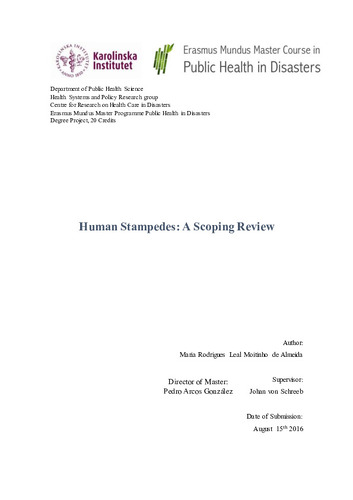Human stampedes: A scoping review
Autor(es) y otros:
Director(es):
Palabra(s) clave:
Stampede
Crowd disaster
Mass gathering
Fecha de publicación:
Serie:
Máster Erasmus Mundus en Salud Pública y Desastres=Erasmus Mundus Master Course in Public Health in Disasters
Descripción física:
Resumen:
Background and Aims Human stampedes are a type of crowd disasters and among the major causes of mortality in mass gatherings. The body of literature regarding human stampedes has increased over the past years but still has not been reviewed. The aim of this study is to summarize available experience on the prevention, preparedness and response to stampedes and outline research gaps of the field. Methods A scoping review with set inclusion and exclusion criteria was conducted. Databases were searched for relevant published and grey literature documents, and a final of 64 documents were included in this review. Results and Discussion Conflicting definitions of human stampedes were found. Several causes for stampedes have been identified, described as a succession of events with a fatal outcome. Several strategies for prevention and preparedness as well as experiences from response to such events are presented. The majority of the documents retrieved were originally from high-income countries whereas stampede events occur mostly in low and middle-income countries, and therefore findings are difficult to generalize. Conclusions Human stampedes are a complex and multifactorial event. To better understand such events, and to improve prevention, preparedness and response, a multisectorial approach is needed. There is no commonly agreed definition of human stampedes. No improvement has been made in the independent reporting of human stampedes.
Background and Aims Human stampedes are a type of crowd disasters and among the major causes of mortality in mass gatherings. The body of literature regarding human stampedes has increased over the past years but still has not been reviewed. The aim of this study is to summarize available experience on the prevention, preparedness and response to stampedes and outline research gaps of the field. Methods A scoping review with set inclusion and exclusion criteria was conducted. Databases were searched for relevant published and grey literature documents, and a final of 64 documents were included in this review. Results and Discussion Conflicting definitions of human stampedes were found. Several causes for stampedes have been identified, described as a succession of events with a fatal outcome. Several strategies for prevention and preparedness as well as experiences from response to such events are presented. The majority of the documents retrieved were originally from high-income countries whereas stampede events occur mostly in low and middle-income countries, and therefore findings are difficult to generalize. Conclusions Human stampedes are a complex and multifactorial event. To better understand such events, and to improve prevention, preparedness and response, a multisectorial approach is needed. There is no commonly agreed definition of human stampedes. No improvement has been made in the independent reporting of human stampedes.
Descripción:
Máster Erasmus Mundus en Salud Pública y Desastres, coordinado por Pedro Arcos González
Colecciones
- Trabajos Fin de Máster [5265]
Ficheros en el ítem




